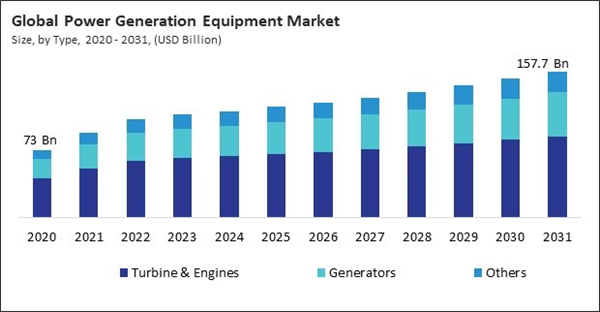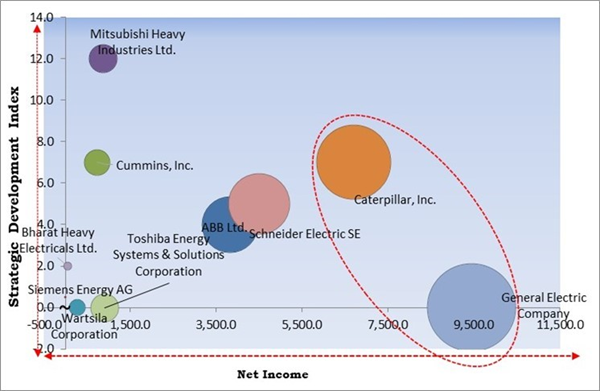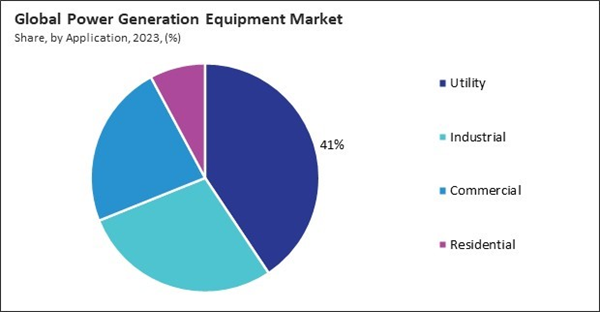The Global Power Generation Equipment Market size is expected to reach $157.7 billion by 2031, rising at a market growth of 4.6% CAGR during the forecast period.
The increasing population and urbanization in the Asia Pacific region drive the demand for electricity to support residential, commercial, and industrial activities, leading to a corresponding need for this equipment. Consequently, the Asia Pacific region would acquire nearly 32% market share by 2030. The Asia Pacific region is home to a significant portion of the world’s population, with rapidly growing urban centers and expanding industrial hubs.
The major strategies followed by the market participants are Partnerships, Collaborations & Agreements as the key developmental strategy to keep pace with the changing demands of end users. For instance, in November, 2023, Mitsubishi Heavy Industries Ltd. came into partnership with Institut Teknologi Bandung, a national research university. Under this partnership, Mitsubishi would reinforce the development of cleaner fuel firing, based on research on ammonia-fired power generation using gas turbines. Additionally, Mitsubishi would move towards the addition of proven technologies in its H-25 gas turbine and ease the awareness of ammonia co-firing in Indonesia. Moreover, in July, 2023, Bharat Heavy Electricals Ltd. partnered with GE, an American multinational conglomerate. Under this partnership, BHEL would procure access and rights for existing, upgraded, and new Gas Turbine models. Additionally, BHEL would also provide gas turbines with fuel blends like hydrogen, methanol, syngas, and more.
Digitalization enables real-time equipment to be monitored, controlled, and optimized through advanced data analytics and artificial intelligence (AI) algorithms. Furthermore, digitalization enables utilities and grid operators to implement demand response programs and optimize energy management. Therefore, growing digitalization and smart technologies are propelling the market’s growth.
The Market is fiercely competitive, driven by innovations in renewable energy, smart grid technologies, and sustainable power solutions. Key players like Siemens, GE Power, and ABB vie for market share, focusing on efficiency, reliability, and environmental sustainability to meet the growing global demand for electricity.
The increasing population and urbanization in the Asia Pacific region drive the demand for electricity to support residential, commercial, and industrial activities, leading to a corresponding need for this equipment. Consequently, the Asia Pacific region would acquire nearly 32% market share by 2030. The Asia Pacific region is home to a significant portion of the world’s population, with rapidly growing urban centers and expanding industrial hubs.
The major strategies followed by the market participants are Partnerships, Collaborations & Agreements as the key developmental strategy to keep pace with the changing demands of end users. For instance, in November, 2023, Mitsubishi Heavy Industries Ltd. came into partnership with Institut Teknologi Bandung, a national research university. Under this partnership, Mitsubishi would reinforce the development of cleaner fuel firing, based on research on ammonia-fired power generation using gas turbines. Additionally, Mitsubishi would move towards the addition of proven technologies in its H-25 gas turbine and ease the awareness of ammonia co-firing in Indonesia. Moreover, in July, 2023, Bharat Heavy Electricals Ltd. partnered with GE, an American multinational conglomerate. Under this partnership, BHEL would procure access and rights for existing, upgraded, and new Gas Turbine models. Additionally, BHEL would also provide gas turbines with fuel blends like hydrogen, methanol, syngas, and more.
Cardinal Matrix - Market Competition Analysis
Based on the Analysis presented in the Cardinal matrix; Caterpillar, Inc. and General Electric Company are the forerunners in the Market. Companies such as Mitsubishi Heavy Industries Ltd., ABB Ltd., Schneider Electric SE are some of the key innovators in the Market. In March 2024, Schneider Electric SE partnered with Mainspring, an Innovative power generation technology company. Under this partnership, Schneider would integrate the power generation technology of Mainspring Energy with its microgrid solution to serve power, energy, and fuel flexibility for commercial and industrial customers. Additionally, Schneider would also help businesses, like data centers and healthcare facilities, to proficiently generate electricity on-site and control in parallel to the power grid.Market Growth Factors
Urbanization and industrialization lead to a surge in energy demand as more people move to urban areas and industries expand. Moreover, in addition to new infrastructure, urbanization and industrialization drive the need to upgrade and modernize existing infrastructure. Hence, the rapid increase in urbanization and industrialization is driving the market’s growth.Digitalization enables real-time equipment to be monitored, controlled, and optimized through advanced data analytics and artificial intelligence (AI) algorithms. Furthermore, digitalization enables utilities and grid operators to implement demand response programs and optimize energy management. Therefore, growing digitalization and smart technologies are propelling the market’s growth.
Market Restraining Factors
Power generation equipment, such as generators, turbines, transformers, and control systems, often require substantial upfront investment. In addition, fluctuations in energy prices and regulatory uncertainty can increase the perceived risk associated with investing in this equipment. Hence, high initial investment costs are hampering the growth of the market.By Application Analysis
On the basis of application, the market is segmented into utility, industrial, commercial, and residential. In 2023, the industrial segment attained a 28% revenue share in the market. The expansion of manufacturing facilities and industrial plants leads to higher electricity consumption and increased demand for this equipment. Industrial companies often invest in new power generation capacity to support their growing production needs and ensure reliable electricity supply.By Type Analysis
Based on type, the market is divided into turbines & engines, generators, and others. The generators segment attained a 30% revenue share in the market in 2023. Many regions around the world are facing challenges with aging power generation infrastructure. As existing power plants and grid systems reach the end of their operational lifespan, they need to be replaced or upgraded. Generators are essential for modernizing power generation facilities and ensuring continued electricity supply.By Regional Analysis
Region-wise, the market is analyzed across North America, Europe, Asia Pacific, and LAMEA. In 2023, the North America region generated 35% revenue share in the market. North America is transitioning towards cleaner energy sources and reducing reliance on fossil fuels. This shift is driven by environmental concerns, climate change mitigation efforts, and regulatory requirements to reduce greenhouse gas emissions. As a result, there is increasing demand for this equipment that utilizes renewable energy sources such as solar, wind, and hydroelectric power.Market Competition and Attributes
The Market is fiercely competitive, driven by innovations in renewable energy, smart grid technologies, and sustainable power solutions. Key players like Siemens, GE Power, and ABB vie for market share, focusing on efficiency, reliability, and environmental sustainability to meet the growing global demand for electricity.
Recent Strategies Deployed in the Market
- Feb-2024: Cummins, Inc. launched C1750D6E and C2000D6E generator sets to extend its portfolio. With the launch of these products, the company would offer reliable power at minimum emissions without affecting performance. Additionally, the new products would provide higher power efficiency at the 1,750-to 2,000-kW 60Hz nodes in a small footprint.
- Feb-2024: Schneider Electric SE unveiled EcoStruxure, a service designed to help extend the life of oil transformers. With the launch of EcoStruxure, the company would serve additional real-time understanding of factors such as heat, oil temperature, water presence, noise, and vibrations.
- Jul-2023: Mitsubishi Heavy Industries Ltd. took over Concentric, LLC, a Material handling equipment supplier in Carrollton, Texas. Under this acquisition, Mitsubishi would include Concentric in its growing portfolio of Smart Infrastructure Solutions. Additionally, Mitsubishi would also get the platform to serve the globe by merging its technology capabilities with the experienced national service provider.
- Nov-2022: Cummins Inc. partnered with Exergy Energy, LLC, a provider of energy management and energy brokerage services. Under this partnership, Cummins would install its power system solutions such as energy storage systems, generator sets, and switching equipment at the location of the customer to power the full operation during grid outages.
- Oct-2020: Mitsubishi Heavy Industries Ltd. partnered with Vestas Wind Systems, a global leader in sustainable energy solutions. Under this partnership, Mitsubishi would form a joint venture for sales of onshore and offshore wind power turbines.
List of Key Companies Profiled
- Mitsubishi Heavy Industries Ltd.
- Wartsila Corporation
- ABB Ltd.
- Siemens Energy AG
- General Electric Company
- Caterpillar, Inc.
- Bharat Heavy Electricals Ltd.
- Schneider Electric SE
- Cummins, Inc.
- Toshiba Energy Systems & Solutions Corporation (Toshiba Corporation)
Market Report Segmentation
By Type- Turbine & Engines
- Generators
- Others
- Utility
- Industrial
- Commercial
- Residential
- North America
- US
- Canada
- Mexico
- Rest of North America
- Europe
- Germany
- UK
- France
- Russia
- Spain
- Italy
- Rest of Europe
- Asia Pacific
- China
- Japan
- India
- South Korea
- Singapore
- Malaysia
- Rest of Asia Pacific
- LAMEA
- Brazil
- Argentina
- UAE
- Saudi Arabia
- South Africa
- Nigeria
- Rest of LAMEA
Table of Contents
Chapter 1. Market Scope & Methodology
Chapter 2. Market at a Glance
Chapter 3. Market Overview
Chapter 4. Competition Analysis - Global
Chapter 5. Global Power Generation Equipment Market, by Type
Chapter 6. Global Power Generation Equipment Market, by Application
Chapter 7. Global Power Generation Equipment Market, by Region
Chapter 8. Company Profiles
Companies Mentioned
- Mitsubishi Heavy Industries Ltd.
- Wartsila Corporation
- ABB Ltd.
- Siemens Energy AG
- General Electric Company
- Caterpillar, Inc.
- Bharat Heavy Electricals Ltd.
- Schneider Electric SE
- Cummins, Inc.
- Toshiba Energy Systems & Solutions Corporation (Toshiba Corporation)
Methodology

LOADING...












